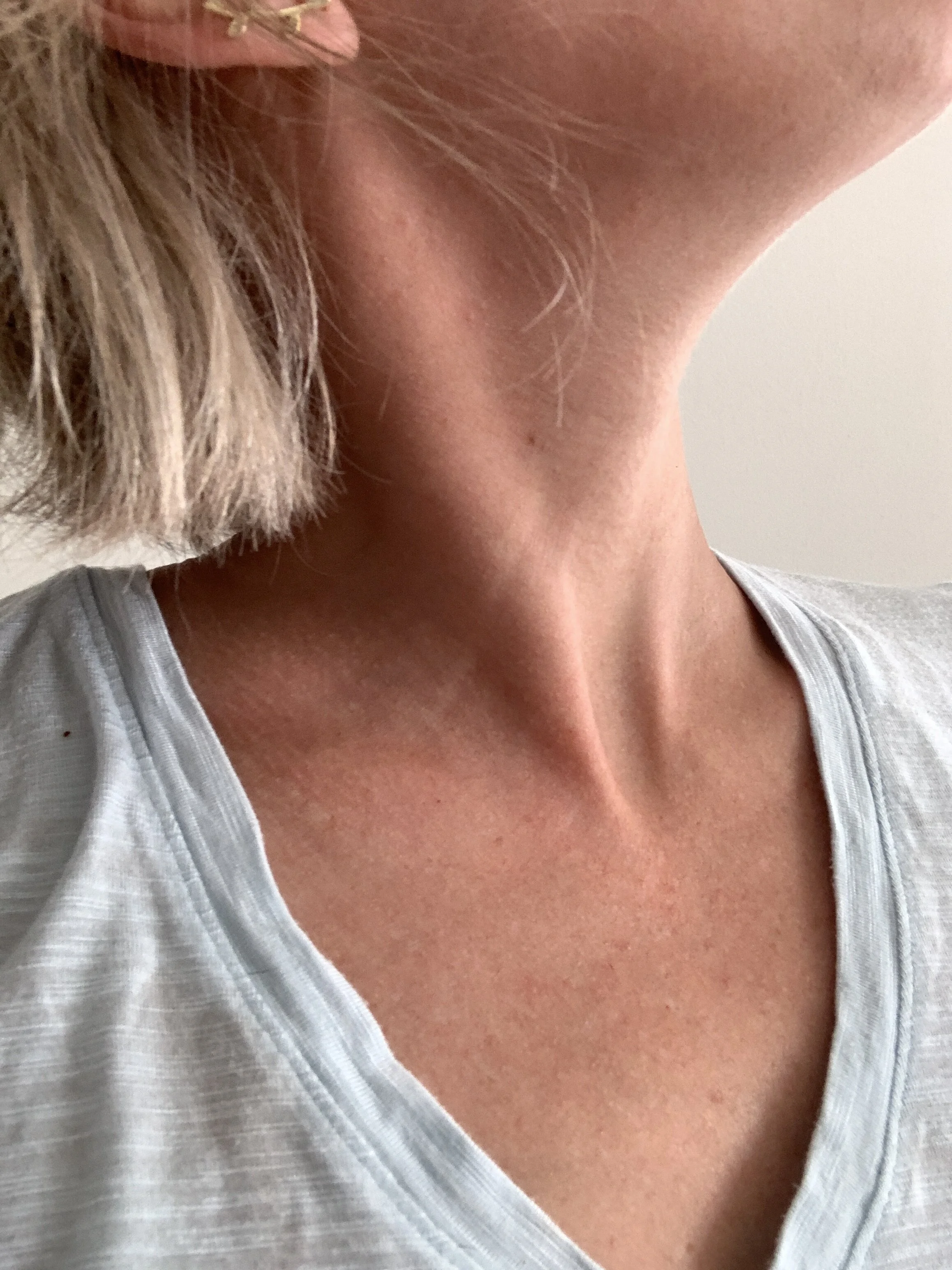Torticollis: Head Tilt or Head Turning Preference In Babies
Torticollis is the medical term for neck turning or tilting. This can be short-term or long-term and can arise at any point in the lifespan. For healthcare professionals involved in the care of infants, we use the term to refer specifically to Congenital Muscular Torticollis (congenital meaning it is present at birth or develops just after birth).
Most commonly the primary muscle involved in Torticollis is the Sternocleidomastoid Muscle (SCM). We have a pair of SCM muscles - a right and a left - each wraps down one side of the neck from the skull behind the ear to the collarbone and breastbone near the center of the body. The diagonal paths of the SCM muscle makes understanding how it impacts head movement and position confusing for parents. Let’s see if we can clear that up
You can actually feel your own SCM muscle! Go ahead and give it a try: tilt your head toward your right shoulder and turn your chin toward your left shoulder. Now touch the sides of your neck. You can usually feel (and see in the mirror) your right SCM muscle bulging and feel tension in the muscle. Feel it behind your ear? Feel where it connects at your collarbone near the center of your chest?
Torticollis can be due to tightening, thickening or shortening of one SCM and/or weakness and lengthening of one SCM. In rare occasions it can also involve a mass or benign tumor within the SCM muscle.
It’s also important to note that very often the asymmetry seen in baby’s neck is also accompanied by asymmetry of the trunk, sometimes called “bodycollis” or “tortisoma,” also caused by soft tissue (muscle and connective tissue) restrictions or imbalances. Evaluation and treatment for Torticollis should always include evaluation and treatment of asymmetry of the trunk muscles (translation: a healthcare provider should visually and physically examine baby with clothing removed down to the diaper during a Torticollis evaluation).
How Common And Treatable Is Torticollis?
While the incidence rates range from 4% to 16% of babies in research, as a clinician I tend to believe it’s on the upper end of that range. Some factors that increase a baby’s risk of Congenital Muscular Torticollis include: birth trauma, intrauterine crowding, multiples, high birth weight.
Usually Torticollis is not an indication of a disease or an underlying developmental disability with baby (deep breaths, fellow anxious parents) - it’s almost always a “standalone diagnosis” with one major exception - PLAGIOCEPHALY, or head flattening. Torticollis and Plagiocephaly are like peanut butter and jelly - they often (but not always) go together!
With early detection and treatment, Torticollis is usually very treatable and resolves quickly. The longer it takes to be treated, the harder it is to completely resolve and the longer treatment takes. For example, if treated in the first month of life, Torticollis is often resolved with only 1.5 months of treatment. If treated after 1 month, it may take up to 6 months of therapy to resolve. And if treated after 6 months of age it may take 9-12 months of therapy and some kiddos won’t see full resolution of their “Tort". So when I say early detection and treatment I mean EARLY. Early early when you’re still trying to figure out how to feed and bathe your new baby.
I advise parents to give their babies under 2 months of age with no head flattening a few weeks to work their way out of minor neck asymmetries with Proactive Positioning and Intentional Repositioning (learn more about that in my free email course). But given the fact that it can take a few weeks to get seen by a professional, I recommend starting the referral process to a therapist as soon as you or your baby’s doctor notices a head tilt or head turning preference or head flattening. If you see resolution of the issue you can cancel the evaluation appointment. Better to have it scheduled when you really realize you NEED it than to start the process then.
What Happens If Torticollis Isn’t Treated Early?
Before I launch into some scary-sounding risks of unresolved Torticollis, let me reiterate that it is usually very treatable and resolves quickly with therapy, especially when caught early. The peanut butter and jelly relationship between Torticollis and Plagiocephaly is one of the reasons I encourage parents to advocate for early evaluation by a therapy professional for head flattening when doctor’s encourage them to “wait and see” if head shape improves on its own.
In the early months, we often we see babies with Torticollis have difficulty rolling toward one side, using two hands together or balancing upright in sitting.
If Torticollis persists it can lead a child to not visually look toward one side as much (or at all) - essentially limiting their vision. For this reason and for muscular reasons, it can lead to a child not using one hand or arm as much or as skillfully as the other. It can lead to spinal curvature once a child is sitting as they try to compensate for the head being off-center. It can affect balance, motor skills and more.
But remember - it is usually very treatable and resolves quickly with therapy, especially when caught early. There are also varying degrees of severity. A mild Torticollis that is only noticeable when a child is very tired or gets sick is less likely to have any long term complications than a child with severe Torticollis that persists into toddlerhood or beyond.
How Can You Tell If Your Baby Has Torticollis?
The classic look of Torticollis is head “tilt and turn.” The head tilts ear to shoulder on one side while the chin rotates towards the opposite shoulder. In some babies either the tilt or the turn will be more pronounced. I quick scroll through photos of your baby on your phone is a GREAT screening tool for Torticollis. Do you notice your baby’s head turning or tilting the same way in most of the photos?
Another clue is redness of the neck folds on one side of baby’s neck. Some babies get minor yeast infections in the neck folds on the same side as the tight SCM muscle.
Head flattening is another clue that Torticollis may be present. Typically if one side of the back of the skull has a flat spot, the SCM on the opposite side is tight. For example a kiddo with left sided head flattening in the back is turning left more than right, indicating a right SCM muscle may be tight. And we could look more closely to see if baby also tilts right ear toward right shoulder.
There are actually 2 reasons why Torticollis leads to head flattening (Positional Plagiocephaly): baby’s head turning preference puts more pressure on one side of the skull AND the increased pull of the SCM muscle on the skull bones on one side of the head encourage asymmetrical bone growth.
One final clue that Torticollis might be present is facial asymmetry. This is also due to the asymmetric pull of the SCM on one side of the head. This asymmetry is often quite subtle but it’s a big clue. Sometimes one side of the mouth is tighter or lower than the other. One eye may appear smaller or lower than the other. One cheek may be more full. The jaw may appear slightly off-center.
How Is Torticollis Treated?
Torticollis is typically treated by a pediatric Physical or Occupational Therapist. Some parents opt to use a chiropractor, cranio-sacral therapist or other soft-tissue therapy provider. However, I encourage parents to use those therapies IN ADDITION TO, not instead of PT or OT. This is because therapists will be tuned in to the impact of the Tort on function and can address movement patterns, reaching and grasping skills, balance, visual skills, etc. in addition to getting at the root of the problem at the neck.
The biggest components of Torticollis treatment rely on caregiver education. That means therapist’s teach and train parents to implement at home program of stretching and repositioning baby. I have found that many pediatricians send parents home with a worksheet of neck stretches instead of referring the baby to PT or OT. If this happens to you, I encourage you to advocate for a referral to PT or OT.
You have a brand new baby. Stretching their tiny neck can feel scary and often times baby resists and cries. Parents often give up because they aren’t comfortable stretching without guidance. If this is you - you are NOT ALONE. Therapists are here to help.
Reflection:
It is very common for parents of babies with Torticollis (and Plagiocephaly) to feel guilt, self-blame and/or regret. If your baby has a head tilt or head turning preference, do you notice any of these emotions surfacing after reading this post?
What is the first action that this information makes you want to take - Go check your baby’s head position? Scroll through your phone to look at photos of your baby’s head positioning? Those are really helpful things to do! Does it make you want to Google image search severe Torticollis? Or do a search for Torticollis complications? Those aren’t helpful things to do and will intensify any feelings of worry or fear you have. *Paying attention to what actions I feel like taking after reading blog posts or articles or social media posts is a new habit I’m working on and it’s really powerful when I remember to do it. Just something to consider…
Worried about your baby’s head shape?
There’s a BOOK for that!
THE FLAT HEAD SYNDROME FIX by Rachel Coley, OT/L.
"Not only did it give me the tools I needed to round out my son's flat spot (and get rid of his head turning preference), it was a surprisingly engaging and enjoyable book to read and I learned so much from it. My son is now 5 months old and his head is round! What a relief!" - relieved parent





